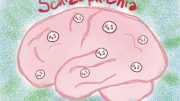
Researchers have identified markers that may indicate early-life susceptibility to schizophrenia, potentially allowing for early detection and intervention. The international research team used blood samples drawn shortly after birth and analyzed 24 million methylation marks, validating their findings with transcriptional data from 595 postmortem brain samples. They concluded that certain differences in methylation in newborns indicate an increased risk of developing schizophrenia later in life.
The ability to predict the risk of developing schizophrenia later in life may allow early detection and intervention.
An international research team led by investigators at Virginia Commonwealth University has identified for the first time markers that may indicate early in life if a person has susceptibility to schizophrenia.
The ability to predict the risk of developing schizophrenia later in life may allow early detection and intervention, which the researchers hope can reduce the impact of the disease on individuals, families, and communities. Their results have been published in the journal Molecular Psychiatry.
Schizophrenia is a serious psychiatric disorder that is most often detected in young adulthood. It affects as much as 1% of the world population and can cause debilitating effects such as a sense of losing touch with reality. People with the disorder are up to three times more likely to die early and often face discrimination, social isolation and debilitating physical illness, according to the World Health Organization.
Although schizophrenia involves an inherited genetic component there is strong evidence that environmental factors play a role in whether a person develops the disease. These environmental factors can trigger chemical changes to DNA that regulate what genes are turned on or off through a process called methylation.
Studying possible genetic triggers for a disease like schizophrenia is complicated because methylation changes can be caused by the disease itself and related factors such as the stress and medications that usually accompany it.
Because of the effects of the disease on the methylome — the term for the set of nucleic acid methylation modifications in an organism’s genome or in a particular cell — ideally samples would be obtained before the disease occurs. But since schizophrenia is a disorder of the brain, this would be impossible.

Edwin van den Oord, Ph.D., and Karolina Aberg, Ph.D., of Virginia Commonwealth University School of Pharmacy’s Center for Biomarker Research and Precision Medicine. Credit: Virginia Commonwealth University
To resolve this problem the research team — led by VCU School of Pharmacy professors Edwin van den Oord, Ph.D, and Karolina Aberg, Ph.D. — devised a unique approach.
First, they examined blood samples that had been drawn shortly after birth from 333 infants in Sweden, tracking 24 million methylation marks. The team used statistical analysis that allowed them to study methylation marks on a cell-type-specific level.
“Since the sampled blood was collected within hours of birth, years before any schizophrenia symptoms occurred, these findings cannot be influenced by the disease itself or other postnatal factors,” noted Aberg, principal investigator for the study and associate director of the Center for Biomarker Research and Precision Medicine at VCU.
Next, the team validated any significant findings from the blood samples by comparing them to transcriptional data from 595 postmortem brain samples from different people — some with schizophrenia and others in a control group who did not have the disease. The brain samples were provided by investigators from around the world including Europe, North America and Australia.
The team also compared their findings against methylation data from adult blood drawn from schizophrenia cases and controls — a total of 2,970 people.
The researchers concluded that certain differences in methylation already present in newborns indicate an increased risk of developing schizophrenia.
“In other words, we could identify methylation differences between individuals that later on in life would develop schizophrenia and controls that are unique to specific cell-types in the neonatal blood,” said van den Oord, the first listed author of the paper in Molecular Psychiatry and director of the Center of Biomarker Research and Precision Medicine. “Research will continue around these methylation differences to develop potential future clinical biomarkers that will allow early detection and intervention.”
Reference: “Genes implicated by a methylome-wide schizophrenia study in neonatal blood show differential expression in adult brain samples” by Edwin J. C. G. van den Oord, Lin Y. Xie, Min Zhao, Thomas L. Campbell, Gustavo Turecki, Anna K. Kähler, Brian Dean, Ole Mors, Christina M. Hultman, Nicklas H. Staunstrup and Karolina A. Aberg, 27 April 2023, Molecular Psychiatry.
DOI: 10.1038/s41380-023-02080-5
This work was supported by a $2.3 million grant from the National Institute of Mental Health. Labwork and analysis took place at VCU’s Center for Biomarker Research and Precision Medicine, which is affiliated with VCU School of Pharmacy.









Be the first to comment on "First-Ever Identification of Schizophrenia Risk Markers in Newborns via DNA Methylation"